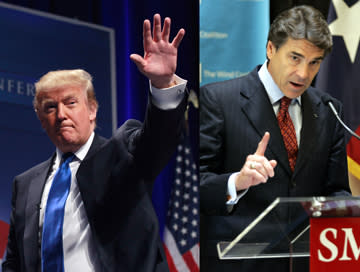 The Ticket
The TicketPrediction markets show that Perry’s early surge is not the same as Trump’s was

As of the morning of Sept. 14, political predictions markets are casting the Republican race for president as a two-person contest. The markets show Texas Gov. Rick Perry with a 37.9 percent likelihood of winning the GOP nomination, while former Massachusetts Gov. Mitt Romney's likelihood is slightly higher, at 38.9 percent likelihood. (These likelihoods are derived mainly as an average of the prices in the major prediction markets; I've explained the process in more detail here.)
Perry had a quick rise to the top of the Republican primary race after he announced his presidential bid a month ago. Perry's rapid ascension through the GOP ranks reminded many commentators of Donald Trump's brief bubble of popularity in GOP polls during the summer--but the Trump and Perry candidacies diverge in important ways, as the evidence from traditional polls and prediction markets both make plain.
Five months ago, on the morning of April 14, national polls showed that Trump--who never announced an official presidential bid--was surging toward the top tier of aspirants to the Republican nomination. These polls, by CNN, Fox, and NBC/WSJ, respectively placed Trump in first, fourth, and second place among preferred Republican candidates. The surveys had Romney--at the time the race's supposed frontrunner--in fourth, second, and first respectively. And the major poll aggregation sites had Trump trending into first or second place in the Republican primary.
But in retrospect, a good deal of the Trump bubble had to with contending streams of information about a high-profile candidate. For the purposes of analysis, we can group the kind of information circulating around any given candidate into three categories: There is, first, the information known to the average Republican voter; then there's the kind of intelligence about a candidate that circulates among people who are more informed about the political process; and finally, there is the vast array of knowledge about the candidate field that has not yet come into public view, and hence is elegantly characterized as "unknown." In category one, for instance, we find the casual perception of Trump as a popular TV personality; a comparable impression of Romney would stem from his tour as Massachusetts governor. In the category of more restrictive and higher-value political intelligence would be the reports on the rocky state of Trump's business affairs and personal life; for Romney, a higher-tier of political knowledge might well concern his standing as a highly successful businessman. In the great "unkown" swath of information, meanwhile, we can group, well, virtually every item of political news between now and Election Day.
Prediction markets permit users to buy and sell contracts on who will prevail in upcoming challenges in politics or any other competitive sphere of activity, from the Oscars to major sporting contests. The players in markets trading in political predictions are typically clued into the second-level sort of political information. Polls, on the other hand, rely only on the information currently known to the average Republican voter. Another way to underscore this knowledge gap is plot it in rough chronological terms: Prediction markets will typically traffic in information that the average Republican voter does not know now, but will likely know by Election Day. In the Trump example, this dynamic meant that higher-value political information was generally neutral or positive for the other candidates, but negative for Trump.
This created a formidable ceiling in the prediction markets that Trump could never punch through. Even though Trump was trending near the top of the polls this spring, the self-selected group of politically informed people who participate in the prediction markets never let him rise very far; he only reached the number four spot in the prediction markets, and even then, only held down that spot briefly. The markets were predicting that the public would learn what they know about Trump and then become less likely to vote for him, relative to the other candidates--and the later flameout of the never officially announced Trump candidacy seemed to bear out the market's predictions.
Perry is no Trump; he has risen to the top in the prediction markets, as well as the polls. This is an important indication that Perry is getting a serious hearing not just from GOP voters, but from political insiders as well. Still, the prediction markets are not quite so bullish on Perry thus far as GOP voters appear to be. Perry is way ahead in the polls (up by six, eight, and twelve points over Romney in the three most recent national polls), but only tied or slightly behind in the prediction markets. This suggests that even though political insiders are giving Perry his due as a legitimate candidate, they are still predicting that his relative strength will wane and Romney will close the race up before the end of the primary season.
David Rothschild is an economist at Yahoo! Research. He has a PhD in applied economics from the Wharton School of Business at the University of Pennsylvania. His dissertation is in creating aggregated forecasts from individual-level information. You can follow him on Twitter @DavMicRot and email him at PredictionBlogger@Yahoo.com.
